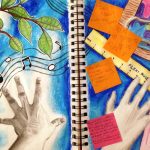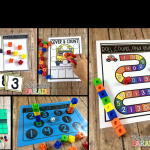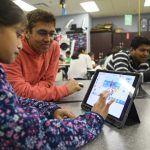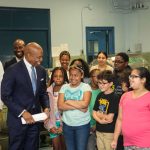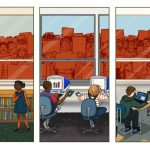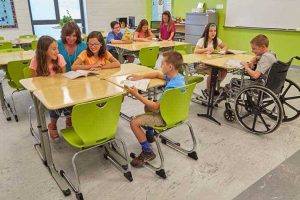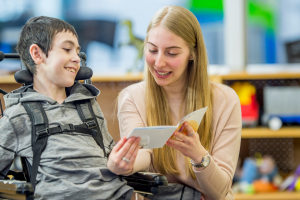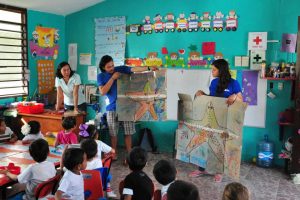
Blended learning combines online and in-person instruction to engage students through diverse mediums. As education pioneer Maria Montessori stated, “Preventing conflicts is the work of politics; establishing peace is the work of education.” Though classroom and virtual models have differences, quality blended learning unifies communities while elevating pedagogy.
Hybrid Classrooms
Hybrid courses blend online modules with face-to-face discussions and hands-on projects under a teacher’s guidance. Partial virtual learning provides flexibility without sacrificing in-person bonds.
Set consistent online expectations like video conference etiquette. Foster relationships through class games and get-to-know-you activities. Gather regular feedback to refine the model based on needs.
With the basics covered onscreen at home, teachers can focus classroom time on collaborative work, experiments, debates and creative applications. A fluid structure keeps students active and connected.
Digital Field Trips
Live-streamed virtual field trips make global learning accessible to any classroom. Students can digitally explore rainforests, volcanoes, museums and Mars without leaving school.
Follow an underwater dive with a marine biologist, witness wildlife on African safaris, stargaze with astronauts, and video chat with peers worldwide. Archived trips allow classes to journey on-demand.
Debrief experiences together. Have students create follow-up projects inspired by virtual excursions. Blending digital discovery with tangible projects enriches education.
Empowering Personalized Pathways
Today’s students have varied needs and skills. Blended models allow more personalized pacing so students can strengthen weaknesses and pursue passions.
Online diagnostic assessments and adaptive programs pinpoint where students excel or struggle, then customize content accordingly through playlists of lessons, games and formative quizzes.
Teachers monitor progress dashboards to provide support. When used thoughtfully, targeted technology narrows achievement gaps.
Cultivating Collaboration
Students should collaborate, not compete. Blended models enable group work and peer teaching online and offline.
Through shared documents and wikis, students co-author, edit, provide feedback and refine products as a team. Virtual breakout rooms and discussion threads expand participation.
Classmates film each other for peer feedback on speeches. Online groups remix content into collaborative multimedia projects. Partners become co-teachers.
These experiences teach teamwork, leadership and community. Blended learning should democratize, not isolate, classroom culture.
Bridging Home Connection
Today’s parents juggle busy lives yet want to support education. Blended models keep families in the loop through digital participation.
Teachers share weekly overviews, documents and newsletters online. Parents comment on discussion boards and access tutoring resources. Videoconference parent-teacher meetings add convenience.
Students guide parents through online portfolios showcasing their work via blogs or videos. Together, parents gain meaningful involvement.
Cultivating Global Citizens
Digital pen pals, podcasts and videoconferences build cross-cultural connections within blended courses.
Students exchange ideas on shared interests, current events and cultural traditions with peers worldwide. They gain global awareness by seeing issues through others’ eyes.
Teachers also partner across classrooms on learning quests mixing virtual and tangible experiences. These relationships teach respect while expanding worldviews.
Reaching Rural Communities
In remote areas, blended learning grants access to specialized curricula. Students take advanced and elective courses online led by qualified teachers.
Digitally share scarce resources like science labs with partnering schools. Rural students can collaborate virtually on group projects. They connect with geographically diverse peers, gaining perspective beyond their hometowns.
Blended learning provides equity, not isolation, for rural districts. With high-speed internet access, remote students break through geographic barriers.
Training Better Teachers
Quality teaching makes or breaks learning outcomes. Blended models improve teacher training and collaboration.
Digitally share best practices across districts. Expand professional development through recorded seminars and social learning. Connect new and veteran educators as virtual mentors.
Let teachers co-develop curricula, assess work samples in shared drives, and monitor student progress across classrooms. Strong communities uplift education.
Sustaining Hybrid Models Post-Pandemic
The COVID-19 pandemic forced a rapid, and often rocky, transition to distance learning. But we should retain beneficial facets while schools reopen.
Maintain digital extensions like educational apps and enhanced communication. Allow some continued schedule flexibility where beneficial.
Sustain relationships between students and teachers developed during closures. Handle leftover trauma and learning gaps with support.
With careful implementation guided by community feedback, blended learning can help schools evolve to meet students where they are.
Blended learning holds potential to personalize, expand and connect education in unprecedented ways. But we must ensure technology strengthens, rather than replaces, human bonds between teachers, families and classmates. Our shared future depends on this community rising together.

